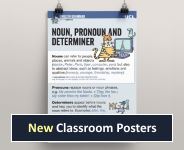Verb identification
In this activity, students work through the criteria for identifying verbs.
Goals
- Practise identifying verbs.
- Recognise linguistic criteria for identifying verbs.
- Remember the list of verb criteria for use and application later on.
Lesson Plan
In this lesson, students move beyond what is called the notional or semantic way of identifying verbs as 'doing words' to explore grammatical ways of identifying verbs. (You can listen to Bas Aarts discuss this.)
Welcome back!

Englicious is totally free for everyone to use!
But you will have to log in to see our library of teaching resources.
If you don’t have an account, that’s perfectly OK. You can register (for free).
It only takes a minute or two.
»
- Printer-friendly version
- Log in to view or leave comments

